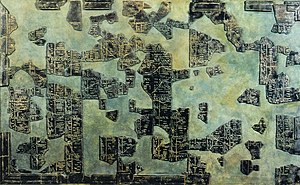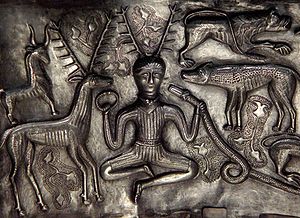Celtic polytheism
Celtic polytheism is the name for a set of beliefs or religion. Another term frequently used for Celtic polytheism is Celtic paganism.[1][2][3] It was originally held by the European people called Celts today. There was a movement to convert these people to Christianity; this process was finished by about 500 AD.
The first findings relating to this set of beliefs can be dated to about 500 BC. The system of beliefs lasted roughly one millennium, in the La Tène period, and the Roman era.
In the case of the Celts on the British Isles, this also included parts of the Iron Age. Celtic polytheism was one of the Iron Age polytheistic religions of the Indo-European family.[4][5]
There are many different names for the gods of the Celtic pantheon. These names have either been recorded by Ancient Greek or Ancient Roman geographers, or they have been found in inscriptions on graves. Among the most prominent of these gods are Teutatis, Taranis and Lugus. People involved in comparative mythology have also added figures from medieval Irish mythology to this list. They say that these figures are deities or heroes from earlier times that have been interpreted in a different way. This process is known as Euhemerisation, after Euhemeros, a philosopher from Ancient Greece who described this process.
According to Roman historians, the Celts practiced human sacrifice as part of their religion. There also seems to have been a caste of "magico-religious specialists",[6] which were called druids in Gaul, Britain and Ireland. Little is known about them today.[7]
The Roman Empire conquered Gaul between 58 and 51 BC, and southern Britannia in the year 43 AD. After this, the Celtic religious practices changed, and elements of Romanisation started to show. This resulted in a Gallo-Roman culture, which had its own Gallo-Roman religious traditions. The number of deities increased, and deities such as Cernunnos were added.
In the 5th and 6th centuries, there was another change, as Christianity became the dominant faith in the Celtic area. It replaced the earlier religions, but influenced later mythology. In the 20th century, a new religious movement called Celtic Neopaganism appeared.
Celtic Polytheism Media
Model reconstructing the Pillar of the Boatmen in the Musée de Cluny, Paris. After 14 AD.
The Strettweg Cult Wagon, c. 600 BC
Image of an antlered figure on the Gundestrup cauldron, interpreted by many archaeologists as being cognate to the god Cernunnos.
Altar depicting a three-faced god identified as Lugus, discovered in Reims.
The mound over the rich Hochdorf Chieftain's Grave, near Eberdingen, Germany. Such burials were reserved for the influential and wealthy in Celtic society.
Reconstruction drawing of Pagans Hill Romano-Celtic temple
Eamhain Mhacha, Ireland
The oak and mistletoe ritual depicted by Henri-Paul Motte (1900)
18th century illustration of Julius Caesar's account.
References
- ↑ Ross, Anne 1974. Pagan Celtic Britain: studies in iconography and tradition. London: Sphere Books Ltd.
- ↑ Hutton, Ronald 1991. The pagan religions of the ancient British Isles: their nature and legacy. Oxford, UK and Cambridge, USA: Blackwell.
- ↑ Jones, Prudence and Pennick, Nigel (1995). A history of Pagan Europe. Routledge.
- ↑ Cunliffe, Barry 1997. The Ancient Celts. Oxford University Press, p184.
- ↑ Ross, Anne 1986. The Pagan Celts. London: B.T. Batsford, p103.
- ↑ in effect, priests
- ↑ Hutton, Ronald 2009. Blood and mistletoe: the history of the Druids in Britain. Yale University Press, p17.


